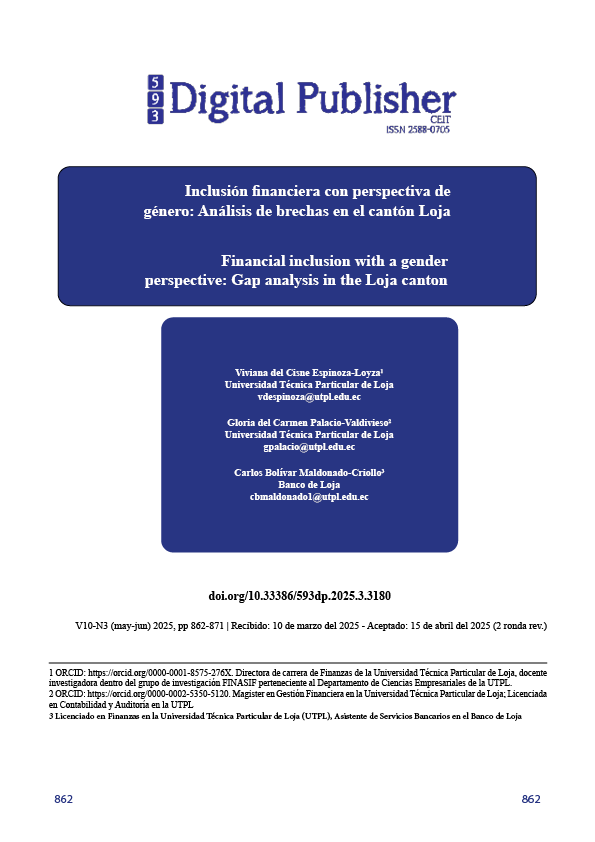Financial inclusion with a gender perspective: Gap analysis in the Loja canton
Main Article Content
Abstract
This research titled "Financial inclusion with a gender perspective: Gap analysis in the Loja canton" analyzes gender inequalities in access to financial services. To do this, a qualitative methodology with an exploratory-descriptive approach is used; 358 surveys were applied to women in the Loja canton to understand their experiences and perceptions of local financial products. The results show that, although many women access financial institutions, they perceive that the services do not meet their needs and they face cultural and product understanding barriers. These practices contribute to the disparity in the granting of credit, pointing out that men have received a higher percentage of credit over the years, despite the fact that women save at a higher level. This underlines the need to address both access and the perceptions and practices that perpetuate female financial exclusion, highlighting the importance of designing more inclusive financial services adapted to the specific needs of women.
Downloads
Article Details

This work is licensed under a Creative Commons Attribution-NonCommercial-ShareAlike 4.0 International License.
1. Derechos de autor
Las obras que se publican en 593 Digital Publisher CEIT están sujetas a los siguientes términos:
1.1. 593 Digital Publisher CEIT, conserva los derechos patrimoniales (copyright) de las obras publicadas, favorece y permite la reutilización de las mismas bajo la licencia Licencia Creative Commons 4.0 de Reconocimiento-NoComercial-CompartirIgual 4.0, por lo cual se pueden copiar, usar, difundir, transmitir y exponer públicamente, siempre que:
1.1.a. Se cite la autoría y fuente original de su publicación (revista, editorial, URL).
1.1.b. No se usen para fines comerciales u onerosos.
1.1.c. Se mencione la existencia y especificaciones de esta licencia de uso.
References
Banco Central del Ecuador. (2020). Estrategia Nacional de Inclusión Financiera. Banco Central del Ecuador. Obtenido de https://rfd.org.ec/docs/comunicacion/DocumentoENIF/ENIF-BCE-2021.pdf
Banco Mundial. (2020). Ecuador recibirá US$260 millones del Banco Mundial para financiar créditos a micro, pequeñas y medianas empresas. Banco Mundial. Obtenido de https://www.bancomundial.org/es/news/press-release/2020/07/01/ecuador-micro-pequenas-medianas-empresas
Bonilla, R., Monteros, A., & Cerezo, V. (2022). Educación y bienestar financiero, tarea pendiente en Ecuador y la región. Red de Instituciones Financieras de Desarrollo. Obtenido de https://rfd.org.ec/docs/2022/estudios/2022%20Estudio%20educaci%C3%B3n%20financiera%20final.pdf
CEPAL. (2011). Panorama social de América latina. Obtenido de https://repositorio.cepal.org/bitstream/handle/11362/1241/1/S1100927_es.pdf
CEPAL. (2021). Panorama Social de América Latina: Transitar hacia la sociedad del cuidado: claves para una recuperación transformadora, con igualdad y sostenibilidad. CEPAL. Obtenido de https://oig.cepal.org/sites/default/files/separata_panorama_social_2021.pdf
Claessens, S. (2006). Access to Financial Services: A Review of the Issues and Public Policy Objectives. Oxford Academic. Obtenido de https://academic.oup.com/wbro/article-abstract/21/2/207/1682372?redirectedFrom=fulltext#no-access-message
INEC. (2010). Resultados Censo Nacional Económico. Ecuador en cifras. Obtenido de https://www.ecuadorencifras.gob.ec/documentos/web-inec/CENEC/Presentaciones_por_ciudades/Presentacion_Loja.pdf
Ley Organica de la Economía Popular y Solidaria. (2018). CONAFPS. Obtenido de https://www.finanzaspopulares.gob.ec/wp-content/uploads/downloads/2019/09/LOEPS.pdf
Roa, M. (2021). Normas sociales: la barrera invisible de la inclusión financiera de la mujer. CEPAL. Obtenido de https://www.cepal.org/es/publicaciones/47539-normas-sociales-la-barrera-invisible-la-inclusion-financiera-la-mujer#:~:text=Se%20concluye%20que%20las%20normas%20sociales%20que%20determinan,financiera%2C%20el%20empoderamiento%2C%20la%20empresarialidad%20y%2
Sánchez, J., & Rodríguez, F. (2015). Educación financiera para la inclusión financiera: una hoja de ruta. Dialnet. Obtenido de file:///D:/Dialnet-EducacionFinancieraParaLaInclusionFinancieraUnaHoj-5555389.pdf
Sotomayor, N., Wrong, S., & Talledo, J. (2018). Determinantes de la inclusión financiera en el Perú: Evidencia Reciente. Superintendencia de banca, seguros y administradoras privadas de fondos de pensiones. Obtenido de https://www.sbs.gob.pe/Portals/0/jer/DDT_ANO2018/DT-001-2018%20(esp).pdf
Tuesta, D., Sorensen, G., Haring, A., & Cámara, N. (2015). Inclusión financiera y sus determinantes: el caso argentino. BBVA. Obtenido de https://www.bbvaresearch.com/wp-content/uploads/2015/01/WP_15-04_Inclusion-Financiera_Argentina.pdf
Verzosi, C., & Carvajal, R. (2023). La Economía Popular y Solidaria en el Ecuador. El empoderamiento femenino. Dialnet. Obtenido de https://ojs.uv.es/index.php/ciriecespana/article/view/17063/22394




